The Southern Ring Nebula (Eight-Burst Nebula, NGC 3132) is a planetary nebula about 2,000 light-years away in the southern constellation Vela. With an apparent magnitude of 9.87 and an apparent size of 62 by 43 arcseconds, it can be observed in amateur telescopes. In 2022, the nebula became one of the first targets of NASA’s James Webb Space Telescope (JWST).
NGC 3132 was nicknamed the Southern Ring Nebula because of its resemblance to the better-known Ring Nebula (Messier 57) in the northern constellation Lyra. The name Eight-Burst Nebula comes from the nebula’s appearance, which resembles the figure 8 in some telescopes.
The Southern Ring Nebula is catalogued as NGC 3132 in the New General Catalogue and as Caldwell 74 in the Caldwell catalogue of deep sky objects visible in amateur telescopes.
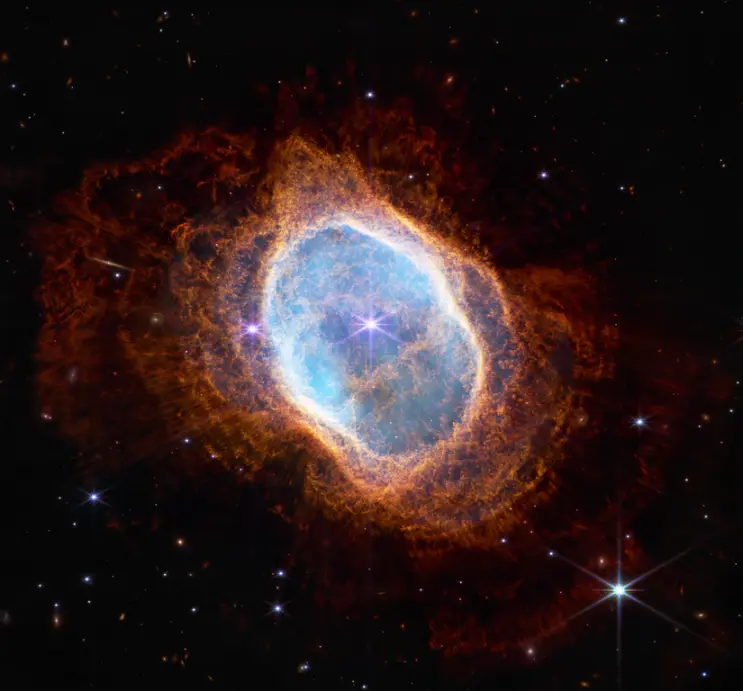
A James Webb Space Telescope near-infrared image of the NGC 3132 planetary nebula, taken using the NIRCAM instrument. Image Credit: National Aeronautics and Space Administration (NASA), European Space Agency (ESA), Canadian Space Agency (CSA), Space Telescope Science Institute (STScI)
Planetary nebulae are the final stage in the lives of intermediate-mass stars (stars with 1-8 times the mass of the Sun) that evolve away from the main sequence and expand into red giants. In the late red giant phase, the stars periodically expel layers of material and ultimately end up surrounded by huge shells of gas and dust. These shells are ionized by the exposed hot stellar cores, the remnants of the central stars. The same fate awaits our Sun in about 6 billion years.
The Southern Ring Nebula and other planetary nebulae are in effect the expelled outer layers of evolved stars that reached the end of their lives. They are called planetary nebulae because their round shape vaguely resembles that of a planet when seen through a telescope. The nebulae do not, however, have anything to do with planets. The origin of the term “planetary nebula” is uncertain, but it was used before the 19th century.
Planetary nebulae are relatively short-lived phenomena. They only last for about 10,000 years before the central stars cool so much that the surrounding nebulosity becomes invisible to us. The Southern Ring Nebula will dissipate in only thousands of years.
The elements contained within planetary nebulae, such as carbon, oxygen, and nitrogen, are recycled into the surrounding space. They may be used to form new stars and planets. New generations of stars formed in these environments tend to have higher metallicities. Even though they only contain relatively small amounts of metals, these elements hugely impact their evolution.
The Southern Ring Nebula has a diameter of 0.4 light-years. It appears almost face-on. If it appeared edge-on, its 3D shape would resemble two bowls connected at the bottom, opening away at the sides with a large hole at the centre.
The expanding cloud of gas was created when an aging star blew off its outer layers, leaving behind a hot remnant core. The central star periodically shed shells of dust and gas in all directions over thousands of years. The ejected material – the glowing gas – now forms the planetary nebula. The ultraviolet light of the central star ionizes the expanding shell, producing the appearance of a brightly coloured nebula.
The central white dwarf has a surface temperature of about 100,000 kelvin. The hot surface of the faint star is heating the gas in the nebula.
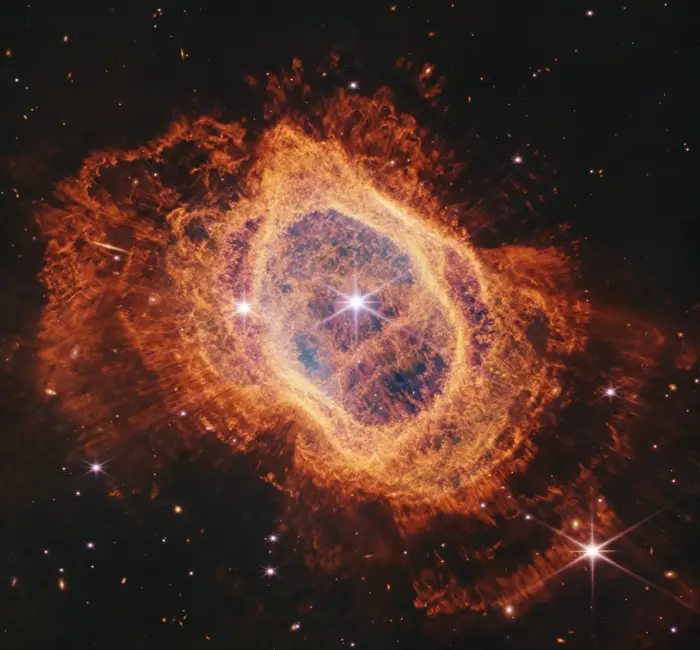
Southern Ring Nebula (JWST), image credit: Judy Schmidt (CC BY 2.0)
The central star has a close 10th magnitude companion. The companion has not yet reached the end of its lifetime, but will likely produce a planetary nebula of its own when it does. The planetary nebula nucleus (PNN) itself is a 16th magnitude star. Both stars are lighting up the nebula’s outer layers. The ejected gas is expanding away from the central white dwarf at a speed of 9 miles per second. The hottest gas lies in the inner region, while the coolest is the farthest from the central star, at the edge of the nebula.
A study published in 2022 reported the discovery of an asymmetrical dust cloud around the central white dwarf with a radial extent of 2 or more arcseconds. The study authors found that the companion star, a white main sequence star of the spectral type A2V, lies 1.696 arcseconds northeast of the white dwarf and is gravitationally bound to it. The results are based on the tracking of relative orbital motion between the two stars over a period of about 20 years, combined with photometric data obtained from the James Webb Space Telescope images in 2022.
The A2V companion, catalogued as HD 87892, was first reported by Méndez in 1978. It forms a physical pair with the central star, which is also confirmed by their similar proper motions obtained in the Gaia Data Release 3. The physical separation between the two stars is 1,277 ± 34 astronomical units. The orbital radius of the binary pair is similar to the radial extent of the dust cloud. The flattening in the cloud on the side facing the A2V star suggests that the cloud and the star are interacting.
The thermal emission from dust indicates a cloud with a radius of at least 1,785 astronomical units, a dust mass of about 1.3 x 10-2 Earth masses, and grains that are 70% silicate and 30% amorphous carbon.
The study authors proposed an evolutionary scenario in which a triple star system – the central star, a close companion, and the more distant A-type star – formed a stable system on the main sequence that later became dynamically unstable, causing the mass ejections from which the planetary nebula formed. The dynamic instability was caused by strong binary interaction between the inner pair, which led to the loss of most of the primary component’s envelope. The severe mass reduction in the central star caused the orbit of the A2V star to expand, resulting in a larger separation between the two stars.
A 2022 study of the Southern Ring Nebula proposed that the star system in the nebula was in fact quadruple. The presence of a second companion star was indicated by the existence of the disk wrapped around the white dwarf. The A-type star lies too far from the white dwarf to have been responsible for the dust disk.
The orbiting companion is believed to have stripped gas away from the central star, speeding up the last stages of its life cycle. The star is either too faint to detect or was possibly destroyed in the interaction and merged with the planetary nebula progenitor.
An international team of almost 70 astronomers also found broken concentric arches in the nebula’s extended halo, indicating the presence of yet another companion. Similar concentric layers were seen in the nebula surrounding the star WR 140, which was also imaged by NASA’s Webb telescope.
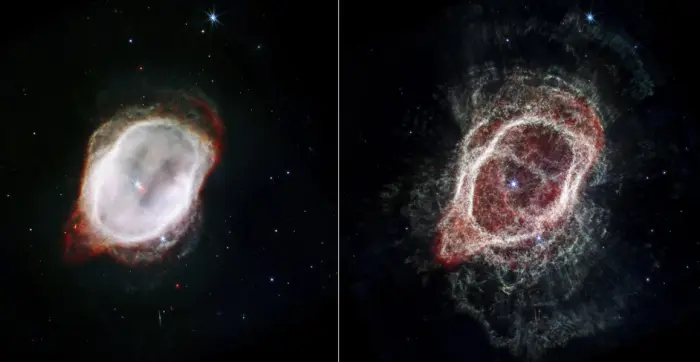
The NASA/ESA/CSA James Webb Space Telescope offers dramatically different views of the same scene! Each image combines near- and mid-infrared light from three filters from the Near-Infrared Camera (NIRCam) and Mid-Infrared Instrument (MIRI).At left, Webb’s image of the Southern Ring Nebula (NGC 3132) highlights the very hot gas that surrounds the central stars. This hot gas is banded by a sharp ring of cooler gas, which appears in both images. At right, Webb’s image traces the star’s scattered outflows that have reached farther into the cosmos. Most of the molecular gas that lies outside the band of cooler gas is also cold. It is also far clumpier, consisting of dense knots of molecular gas that form a halo around the central stars. Image credit: NASA, ESA, CSA, STScI, O. De Marco (Macquarie University), J. DePasquale (STScI) (CC BY 4.0)
The ring of hot gas heated by the central white dwarf has protuberances that indicate the presence of multiple stars. 3D modelling using data from the European Southern Observatory (ESO) with the image obtained with the JWST has revealed that the protuberances come in pairs and move in opposite directions from the central star. Astronomers believe that the close interaction that produced the dusty disk may have involved not one but two close companions. The chaotic interaction with the central star may have produced the jets that pushed out these protuberances.
The presence of additional companions has not been confirmed. The study authors propose with a good degree of certainty that the star system that created the nebula contains the pair of stars that appear as the nebula’s two eyes, a star responsible for ripping away the gas to form the disk around the central star, and another companion that left the concentric arches in the egg-shaped gas bubble that forms the nebula’s ring.
The study was led by Orsola de Marco, Professor of Astrophysics at the Macquarie University in Sydney, Australia. It was published in Nature Astronomy in December 2022.
James Webb Telescope image
The Southern Ring Nebula was one of the first targets of NASA’s James Webb telescope, the successor to Hubble. An image of NGC 3132 was released along with those of the galaxy group Stephan’s Quintet in the constellation Pegasus, the Carina Nebula in Carina, the deep field view of the galaxy cluster SMACS 0723 in Volans, and the exoplanet WASP-96b in Phoenix.
The JWST images of the Southern Ring Nebula were captured with the Near-Infrared Camera (NIRCam) and Mid-Infrared Instrument (MIRI) and unveiled on Tuesday, July 12, 2022. The exposure dates were June 3 (NIRCam) and June 12, 2022 (MIRI). The NIRCam image has a higher resolution, while the MIRI image reveals the dust around the central stars. NIRCam was built by teams at the University of Arizona and Lockheed Martin’s Advanced Technology Center, while MIRI was designed and built by a consortium of European Institutes in collaboration with the Jet Propulsion Laboratory (JPL) and the University of Arizona.
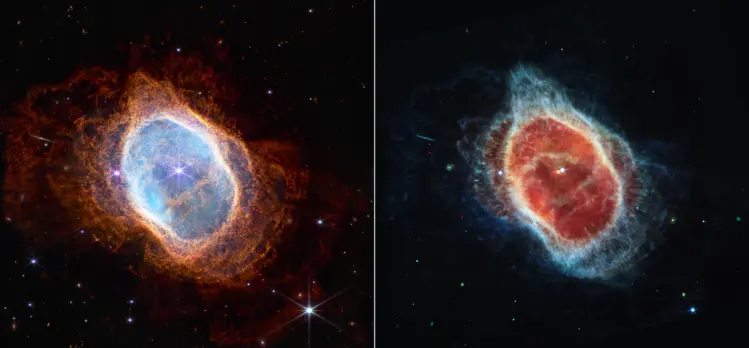
This side-by-side comparison shows observations of the Southern Ring Nebula in near-infrared light (L) and mid-infrared light (R), from NASA’s Webb Telescope. The central star has a white dwarf orbiting it to the lower left.
In the Near-Infrared Camera (NIRCam) image, the white dwarf is partially hidden by a diffraction spike. The same star appears – but brighter, larger, and redder – in the Mid-Infrared Instrument (MIRI) image. The images look very different because NIRCam and MIRI collect different wavelengths of light. NIRCam delivers higher-resolution images, while MIRI goes farther into the infrared and can see gleaming dust around the stars. Image: NASA, ESA, CSA, STScI
The Webb observations show a much more detailed view of the Southern Ring Nebula than the Hubble images.
The white dwarf appears larger and reddish in mid-infrared wavelengths because it is embedded in a dense layer of dust. The star has probably expelled its last layers by now and it is unclear why it is cloaked in dust. The material may have been transferred from the brighter companion. The companion, appearing blue in the MIRI image, is in a tight orbit. It has not yet reached the final stages of its life cycle.
The companion orbits the hot white dwarf as the latter periodically expels shells of material, and it helps distribute the ejected gas and dust. Together, the star system produces the nebula’s wispy asymmetrical shells.
Each shell of gas is the product of a mass loss episode. The widest cooler shell was expelled earlier, while those closer to the center of the nebula were ejected more recently. The central star has expelled at least eight layers of dust and gas over the last several thousand years. The shells allow astronomers to study the history of the system. The distribution of molecules within the gas cloud will help further the understanding of these objects.
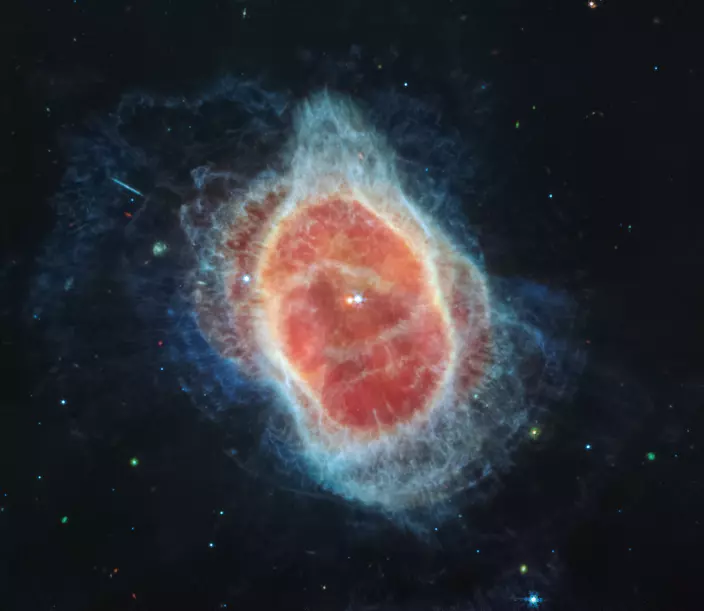
The Southern Ring Nebula – This Mid-Infrared Instrument (MIRI) image also offers an incredible amount of detail, including a cache of distant galaxies in the background. Most of the multi-colored points of light are galaxies, not stars. Tiny triangles mark the circular edges of stars, including a blue one within the nebula’s red bottom-most edges, while galaxies look like misshapen circles, straight lines, and spirals. Credit: NASA, ESA, CSA, STScI
A blue filament appearing on the left side of the mid-infrared image is an edge-on galaxy. Zooming in on the galaxy in the near-infrared image will reveal its dark dust lane. It is the most conspicuous of the distant galaxies captured by the JWST. The galaxies that appear small and red are the farthest away. The full-resolution images of the nebula can be downloaded at WebbTelescope.org.
The near-infrared image of the Southern Ring Nebula reveals the holes in the gas that allow the light of the central stars to pass through. The fine rays of light are visible in the image. Some of the starlight cannot escape from areas in the central region where the dust and gas are denser. The central white dwarf appears along the diffraction spikes of the companion, at the 8 o’clock position.
The James Webb Space Telescope, the most powerful orbital space telescope built to date, is an international project led by NASA, the European Space Agency (ESA), and the Canadian Space Agency (CSA). Launched on December 25, 2021, the vast telescope was designed primarily for infrared astronomy. Its resolution and sensitivity allows astronomers to study the formation of the first galaxies, investigate stellar nurseries and potentially habitable exoplanets, and see the light of objects formed in the early universe. In addition to capturing spectacular cosmic objects, these observations help scientists gain a better understanding of the universe and how it evolved after the Big Bang.
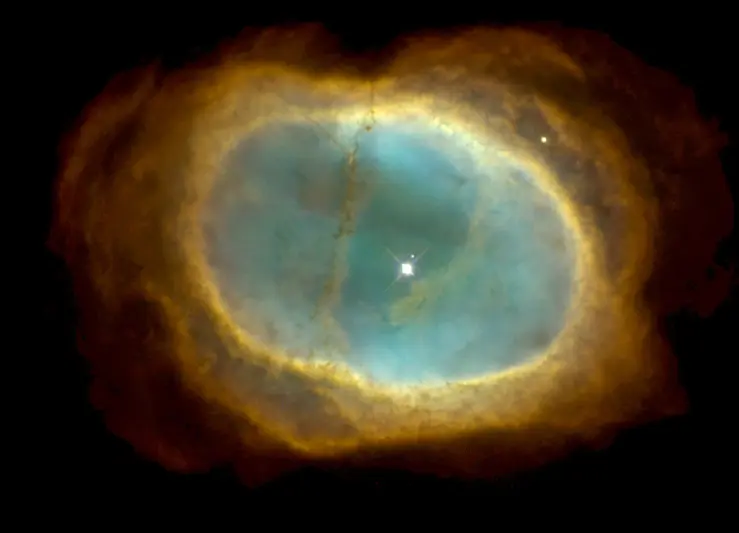
NGC 3132 is a striking example of a planetary nebula. This expanding cloud of gas, surrounding a dying star, is known to amateur astronomers in the southern hemisphere as the Eight-Burst or the Southern Ring nebula. Image: Hubble Heritage Team (STScI/AURA/NASA/ESA)
NGC 3132 was previously imaged by the Wide Field and Planetary Camera 2 (WFPC2) on NASA’s Hubble Space Telescope in the mid-1990s. The image of the nebula was taken in December 1995 and released in November 1998.
The image produced by the Hubble Heritage Team at the Space Telescope Science Institute (STScI) showed the two stars at the centre of the nebula: a bright one and a much fainter companion. The fainter star is the central white dwarf. It lights up the surrounding nebula with ultraviolet radiation that makes the nebular material fluorescent. The nebula’s unusual shape and the asymmetries of its structure captured in Hubble’s 1-hour exposure are still not well understood.
Location
The Southern Ring Nebula lies in the constellation Vela, on the border with Antlia. It can be found roughly halfway from Suhail (Lambda Velorum) to Iota Antliae.
The nebula is largely unknown to observers in the northern hemisphere because it stays below the horizon for most of the year. It makes an appearance low above the southern horizon in the winter months. Lying at declination 40° 26’ S, it cannot be seen from locations north of the latitude 48 – 49° N.
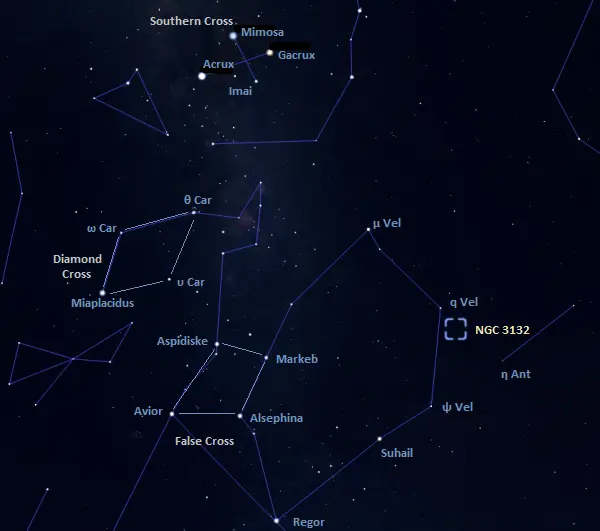
The location of the Southern Ring Nebula (NGC 3132), image: Stellarium
Observers in the southern hemisphere can see the Southern Ring Nebula for most of the year. The nebula is one of the most popular targets among amateur astronomers. Telescopes will reveal the nebula’s oval shape, but the intricate filaments and details of the nebula’s structure can only be captured photographically.
The best time of year to see the stars and deep sky objects in Vela is during the month of March, when the constellation rises high above the horizon in the evening sky.
Southern Ring Nebula – NGC 3132
| Constellation | Vela |
| Right ascension | 10h 07m 01.7656422504s |
| Declination | −40° 26′ 11.130553032″ |
| Apparent magnitude | 9.87 |
| Apparent size | 62” x 43” |
| Diameter | 0.4 light-years |
| Distance | 2,000 light-years (613 parsecs) |
| Names and designations | Eight-Burst Nebula, Southern Ring Nebula, NGC 3132, Caldwell 74, ESO 316-27, Hen 2-40, PK 272+12 1, PKS J1007-4026, PKS 1004-401, PN G272.1+12.3, VV 54, VV’ 94, ARO 504, StWr 4-8, WRAY 15-501 |